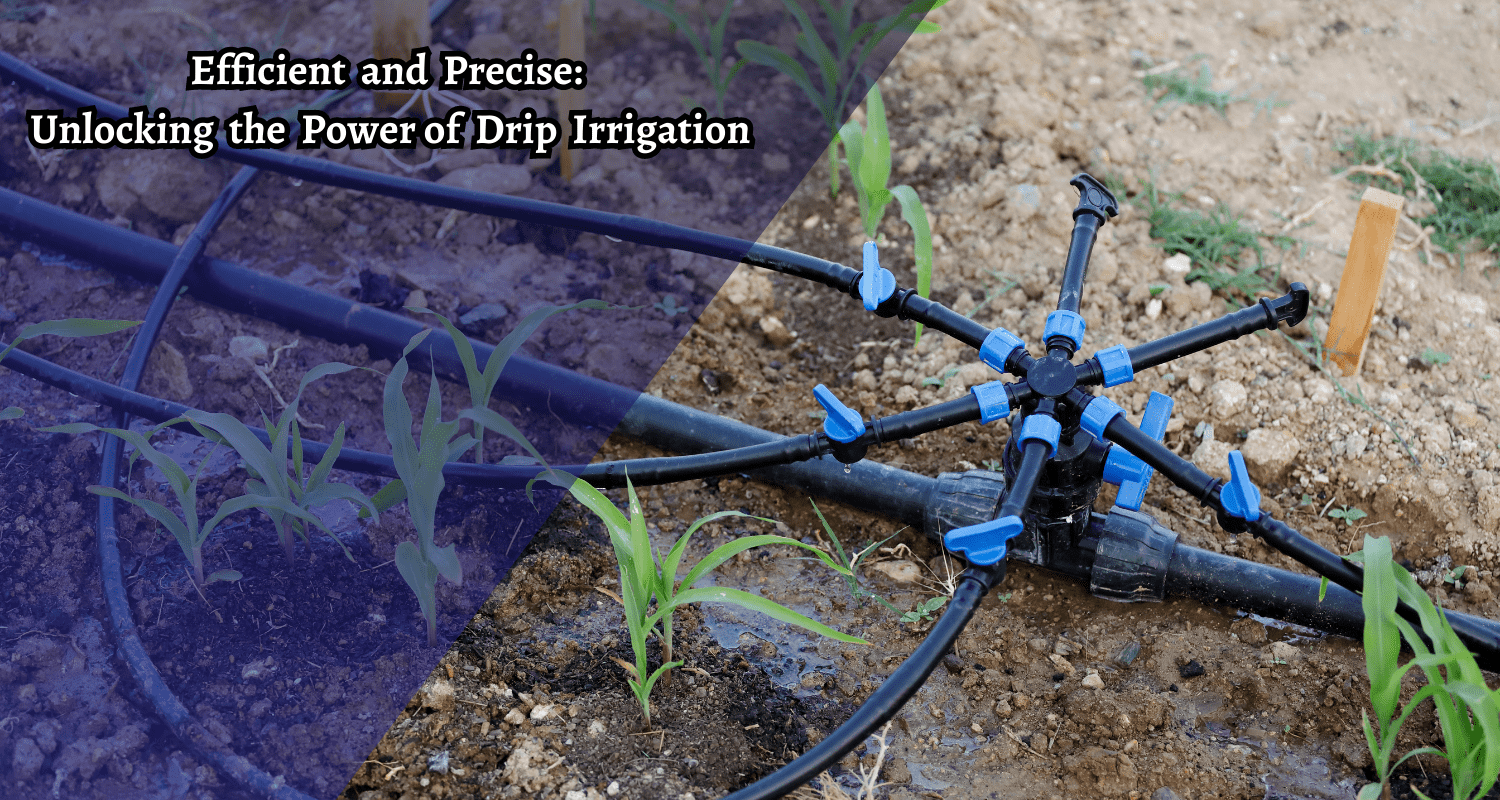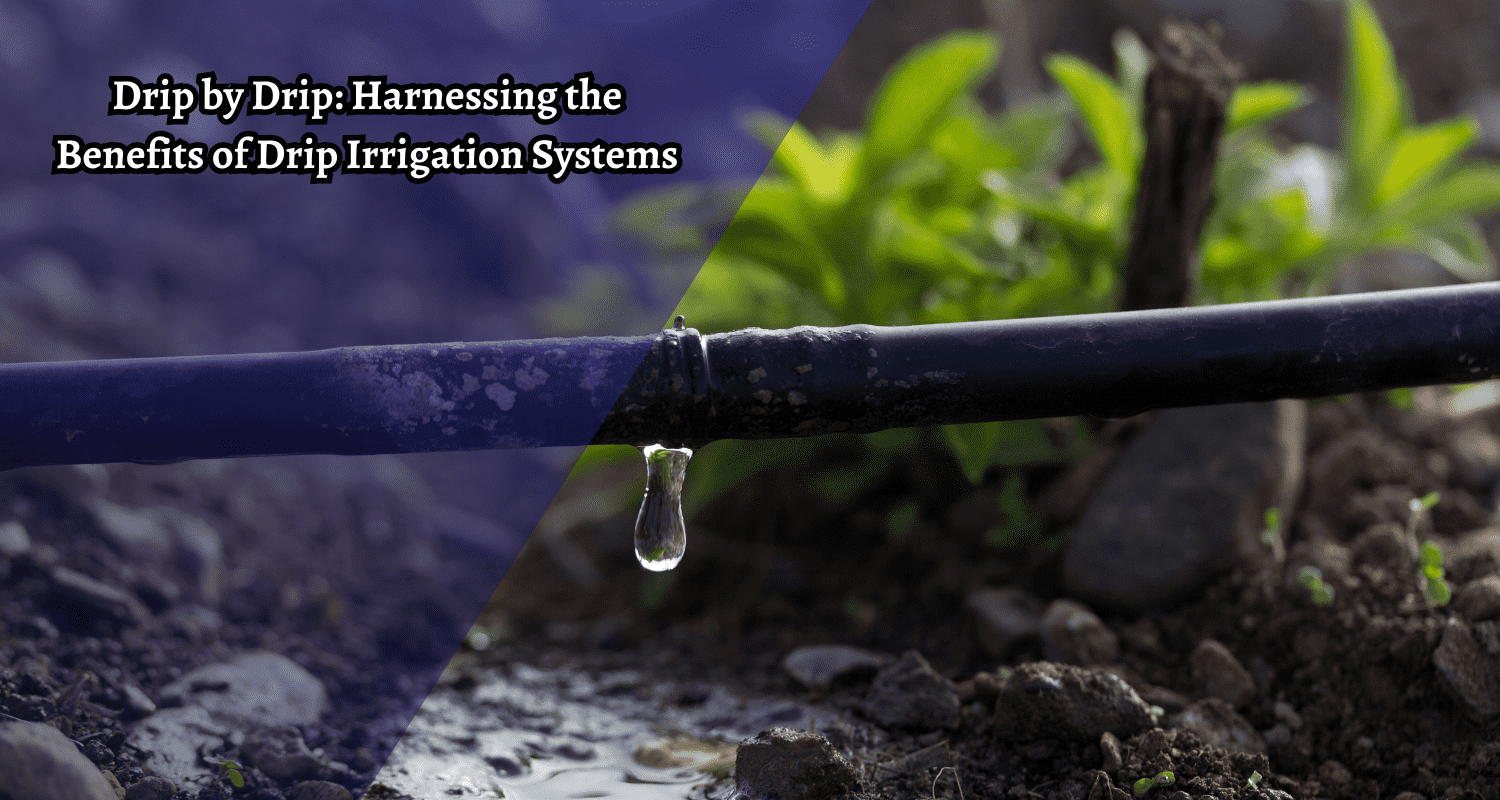Drip irrigation is a highly efficient method of watering plants that delivers water directly to the roots. It minimizes waste and maximizes plant health. Whether you have a small garden or a large agricultural field, drip irrigation can be a game-changer regarding water saving and plant growth. In this article, we will guide you through the basics of drop irrigation. Also helping you to get started on your journey to more efficient and sustainable watering practices.
Table of Contents
Introduction to Drip Irrigation
Drip irrigation, also known as micro-irrigation or trickle irrigation, is an ingenious and efficient way to water plants. At some point, people in Pakistan refer to Drip Irrigation as Drop Irrigation. Unlike traditional sprinkler systems that spray water over a wide area, drip irrigation delivers water drop by drop directly to the plant’s root zone. This targeted approach ensures that each plant receives just the right amount of water, minimizing waste and maximizing plant health.
By using special tubes or pipes with tiny holes near each plant, Drip irrigation allows water to slowly and evenly drip into the soil, mimicking nature’s way of hydration. This not only saves water but also promotes optimal plant growth. Whether you have a garden, farm, or city landscape, drip irrigation can be customized to suit your needs, making it a versatile and environmentally friendly solution. Experience the magic of drip irrigation as we delve into its benefits and explore how it can revolutionize how we care for plants and protect our precious resources.
Types of Drop Irrigation
Drop-by-drop irrigation systems are available in two types: subsurface drip irrigation and surface drip irrigation. Let’s examine each type more closely.
Subsurface Drip Irrigation
Subsurface drip irrigation (SDI) involves burying narrow tubes at a 20-50 cm depth to prevent interference on the soil surface.
These tubes can be either porous or non-porous.
- Porous Tubes: These tubes continuously release water into the soil.
- Non-Porous Tubes: These tubes have emitters that release water at specific points. SDI is commonly used in fruit tree plantations and perennial crops.

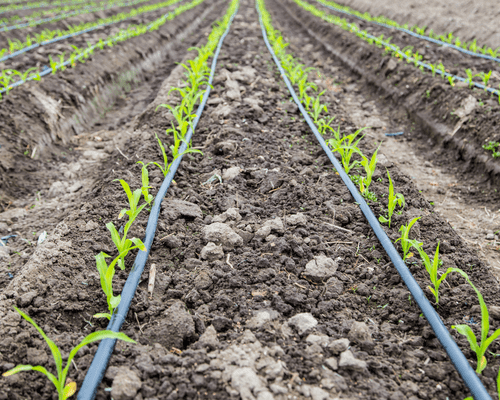
Surface Drip Irrigation
Surface drip irrigation is a drip irrigation system that is installed above the soil surface. It utilizes emitters or drippers to regulate the flow rate and amount of water.
Drip Line Tubing and Drip Tape:
Emitters and drippers can be connected using drip line tubing or drip tape. Drip tape is a thinner tubing option that is quicker and easier to install but less permanent. On the other hand, drip line pipes are thicker and more durable, capable of withstanding higher water pressure.
Types of Surface Drip Irrigation Emitters:
- Point-Source Emitters (Drip Bubbler): These emitters are inserted into the tubes.
- In-Line Drip Emitters: These emitters are joined to the lateral supply tubes.
- Basin Bubblers: Basin bubblers utilize a round or square basin around the plant, concentrating and delivering water to that specific plant.
- Micro Spray Sprinkler: This type of emitter rotates to cover larger areas.
What Components Do I Need For Drip Irrigation?
| Component | Description | Price Range (PKR) |
|---|---|---|
| Drip Irrigation Kits | Vast kits include tubing, emitters, connectors, filters, and regulators. | 1,000 – 5,000 |
| Drip Irrigation Tubing | Flexible and durable polyethylene tubing available in different diameters | 100 – 300 per meter |
| Emitters | Devices controlling water flow, such as drip emitters, micro-sprinklers, and bubblers | 20 – 100 each |
| Filters | Removes debris and sediment from water, like screen filters and disc filters | 200 – 500 each |
| Pressure Regulators | Maintains constant and right water pressure in the system | 300 – 800 each |
| Backflow Preventers | Prevents the reverse flow of water and protects against contamination | 500 – 1,500 each |
| Connectors and Fittings | Joins different components, including tees, elbows, couplings, and end caps | 10 – 50 each |
| Timer or Controller | Automates irrigation schedule sets watering durations and intervals | 500 – 2,500 |
How to Choose the right micro irrigation system for your needs?
When selecting a micro irrigation system, consider the following factors:
Water Source: Consider the availability and pressure of your water source to determine the type of system that best suits your needs.
Plant Types: Different plants have different water requirements. Select emitters with the proper flow rate for each plant type.
Garden Layout: Consider the size and layout of your garden or field to determine the length and structure of the distribution tubing.
Budget: Drip irrigation systems come in various price ranges. Determine your budget and look for systems that offer the best value for your money.
Automation: Decide if you want to automate your system with timers or sensors that control the irrigation schedule based on soil moisture levels or specific time intervals.

Prices of Drip Irrigation System
| Drip Irrigation System Type | Price Range (in PKR) | Life Span |
|---|---|---|
| Basic Drip System | 50,000 – 80,000 | 5 to 7 years |
| Mid-Range Drip System | 80,000 – 120,000 | 7 to 10 years |
| High-End Drip System | 120,000 – 200,000 | 10 to 15 years |
Tips when Choosing the Best Drip Irrigation System for Your Farm
- Consider farm size, crop types, and water requirements.
- Learn about drip, sprinkler, center pivot, and flood irrigation options.
- Evaluate the reliability and quality of water sources.
- Choose a system that suits your soil type and farm terrain.
- Look for sustainable systems with energy-saving features.
- Seek systems with advanced control options for efficient water usage.
- Compare prices, durability, and ongoing maintenance costs. Consult AgriThing’s advisory consultant for personalized recommendations.
Get your 8/12 PVC Branch Pipe Micro Spray for Drip Irrigation, Garden Irrigation, and more at Agricomplex. Don’t wait, shop now!
Drip Irrigation
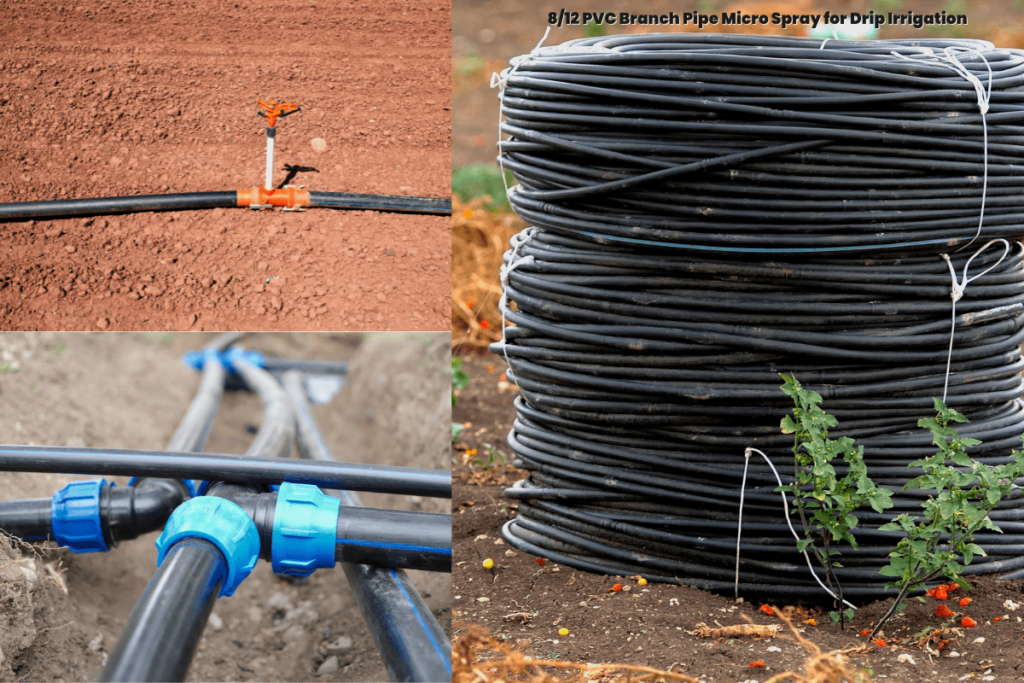
How to Plan and design your trickle irrigation system?
Proper planning and design are crucial for the success of your trickle irrigation system. Follow these steps:
Evaluate Your Landscape:
Take note of the plant types, water requirements, and location within your garden or field.
Measure and Map:
Measure the dimensions of your garden or field and create a detailed map. It includes the location of plants, water sources, and other relevant features.
Determine Water Requirements:
Research the water needs of your plants and calculate the flow rate required for each plant type.
Divide into Zones:
Divide your field into zones based on plants with similar water requirements. This measure allows efficient water management.
Create a Layout:
Design the layout of your micro irrigation system. It includes the placement of emitters, tubing, and connectors. Consider the slope, elevation changes, and water pressure in your design.
How to Install a drop-by-drop irrigation system?
Agrithing installs efficient controlled irrigation systems. Our skilled team designs and installs custom solutions for different agricultural needs. Micro irrigation delivers water directly to plant roots, saving water and promoting plant growth. Our process includes the following:
Prepare the Area:
Clear the area of any debris or obstacles that may interfere with the installation process.
Lay Out the Tubing:
Lay the distribution tubing according to your design. Also, ensure it reaches all the plants in the respective zones.
Connect the Components:
Connect the tubing, emitters, connectors, and fittings according to the layout plan. Use the right tools and techniques to create secure connections.
Flush the System:
Before attaching the emitters, flush the system to remove any dirt or debris that may have entered during installation.
Install the Emitters:
Install the emitters at the designated locations for each plant. Also, ensure proper spacing and flow rate.
Test the System:
Turn on the water supply and check for any leaks or malfunctions. Make necessary adjustments to ensure optimal performance.
The image provided showcases a demonstration of the installation of drip irrigation.
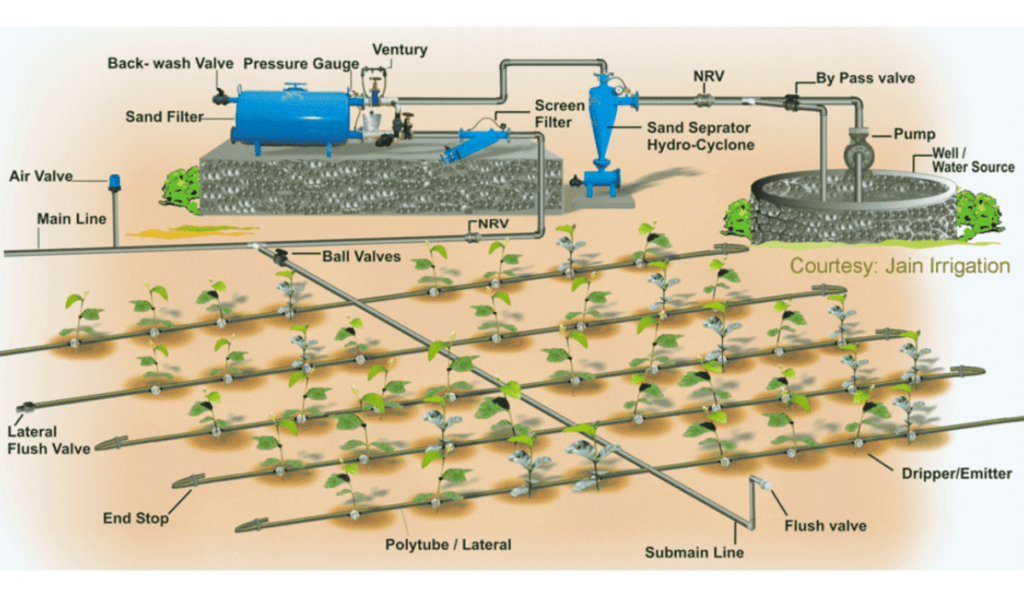
Why Proper maintenance of a drip irrigation system is necessary?
Regular maintenance is essential to keep your micro irrigation system in good working condition. Follow these maintenance practices:
Monitor Water Flow:
Regularly check the flow rate and distribution of water from the emitters. Adjust or replace emitters as needed.
Inspect for Leaks:
Check for leaks or damage in the tubing, connectors, and emitters. Repair or replace any faulty components.
Clean Filters:
Sometimes, clean or replace the filters to prevent clogging and keep proper water flow.
Winterization:
If you live in a region with freezing temperatures, drain and winterize your drip irrigation system before the start of winter to prevent damage.
System Flushing
Wash the system occasionally to remove any residue or buildup that may cause clogging.
What are Common Troubleshooting Issues in Drip Irrigation?
| Problem | Possible Causes | Solutions |
|---|---|---|
| Low Water Pressure | Blocked emitters or filters | Clean or replace blocked emitters or filters |
| Low water supply | Check the water source and ensure a good supply of water | |
| Incorrectly sized tubing or connectors | Ensure the tubing and connectors are the fit sizes for optimal water flow. | |
| Clogging of Emitters | Sediment or debris in the water | Install additional filters or use emitters with built-in filters to prevent clogging |
| Low-quality or incompatible emitters | Replace emitters with higher quality ones or those specifically designed for your system | |
| Uneven Water Distribution | Improperly installed or damaged tubing | Inspect and repair any damaged or incorrectly installed tubing to ensure uniform water flow |
| Incorrectly positioned emitters | Adjust emitters to ensure equal water distribution across plants | |
| Bad water pressure | Check pressure regulators and ensure they are set at the proper level | |
| Leakage in the System | Loose connections or damaged fittings | Tighten all connections and replace any damaged fittings or connectors |
| Tubing punctures or cracks | Patch or replace damaged tubing to prevent leaks | |
| Excessive water pressure | Install pressure regulators to control the water pressure within the system | |
| System Not Operating | Malfunctioning timer or controller | Check and reset the timer or controller, or replace if necessary |
| Electrical issues or power outage | Ensure a stable power supply and address any electrical problems | |
| Blocked or damaged valves | Inspect and repair or replace valves as needed |
How to Manage and Conserve Water with Precise Irrigation?
Drop irrigation provides significant advantages for water management and conservation. Here’s how you can maximize these benefits:
Water Scheduling:
Establish a watering program based on your plant’s water requirements, considering weather conditions, soil moisture, and plant growth stage.
Mulching:
Establish a watering program based on your plant’s water requirements, considering weather conditions, soil moisture, and plant growth stage.
Rainwater Harvesting:
Consider collecting rainwater and mixing it into your drip irrigation system to increase your water supply and decrease dependence on other sources.
Smart Irrigation Controllers:
Utilize intelligent controllers that adjust watering schedules based on weather data and soil moisture levels. Thus, ensuring proper and efficient water management.
Monitoring and Adjustments:
Regularly monitor soil moisture levels, plant health, and water usage, and adjust your system and watering practices.
“Sprinkling Irrigation can be seen in the following image”
Agrithing
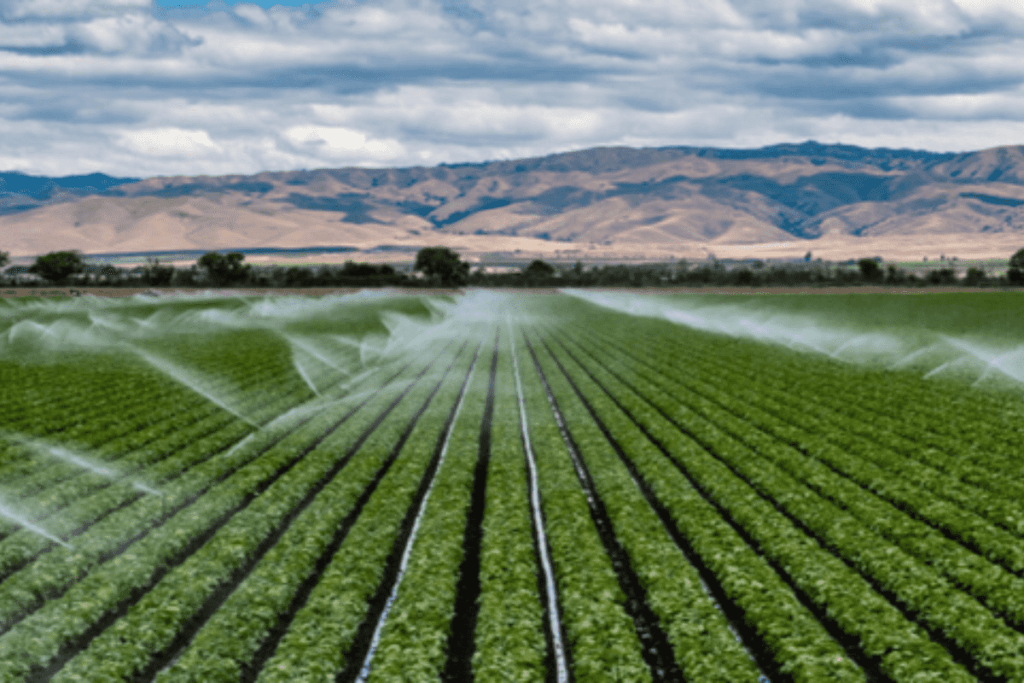
Tips for Successful Drip Irrigation
Consider these tips to ensure a successful drip irrigation experience:
Regular System Checks:
Inspect your system for leaks, clogs, or other issues and address them to maintain optimal performance.
Proper Emitter Selection:
Choose emitters that match your plants’ water requirements, as different plants have varying needs. Using the right emitters is crucial for success.
Maintain Consistent Pressure:
Regularly check and adjust the pressure regulator to maintain a consistent flow rate throughout the system.
Monitor Plant Health:
Regularly observe the health and growth of your plants, and adjust the watering schedule or make system changes as needed.
Stay Informed:
Continue learning about drop-by-drop irrigation techniques, best practices, and new technologies. Stay updated with advancements in the field to enhance your irrigation methods.
How does Drip Irrigation improve Plant Growth and Health?
Drip irrigation creates optimal conditions for plant growth and health. Here’s how it benefits your plants:
Reduced Stress:
Drop irrigation delivers water directly to the root zone. Thus, reduces water stress on plants and promotes healthier growth and development.
Improved Nutrient Uptake:
Precise water application through trickle irrigation distributes nutrients in the soil, enhancing plant nutrient uptake.
Reduce Weed Competition:
By delivering water only to the plants’ root zones, micro irrigation minimizes water availability for weeds, reducing competition and promoting plant growth.
Prevention of Foliage Diseases:
Precise irrigation keeps foliage dry, minimizing the risk of moisture-related foliage diseases.
Optimal Root Development:
Micro irrigation’s gradual and consistent water delivery encourages deep and robust root growth, making plants more resilient.
The image depicts a sub-surface drip irrigation system being utilized for watering home-decorated plants.
Agrithing

Cost Considerations of Micro Irrigation
The cost of a Micro Irrigation System depends on factors such as the size of your garden or field, system complexity, and component quality. While the initial investment may be higher than traditional irrigation methods, the long-term benefits and water savings make it useful.
Consider the following cost considerations:
System Components:
Research and compare prices of different brands and suppliers for tubing, emitters, connectors, filters, and regulators.
Installation Costs:
If you lack confidence in your DIY skills, you may need to hire a professional for system installation. Take these costs into account when budgeting for your Drop Irrigation System.
Water Savings:
Factor in the potential water savings achieved through drop irrigation. Over time, reduced water usage can lead to notable cost savings.
Maintenance and Repairs:
Consider ongoing maintenance costs, such as emitter replacement, filter maintenance, or repairs for any damages that may occur.
Return on Investment:
Evaluate the long-term benefits of precise irrigation, such as increased plant yield, reduced water bills, and improved plant health. These factors contribute to the overall return on investment.
Comparing Drop-by-Drop Irrigation with other Irrigation Methods
| Aspect | Drip Irrigation | Sprinkler Irrigation | Hand Irrigation |
|---|---|---|---|
| Water Efficiency | High | Moderate | Low |
| Water Distribution | Precise, targeted to the root zone | Wider coverage, prone to evaporation and runoff | Dependent on the user’s control |
| Water Conservation | Minimizes water waste | Moderate water loss | High water loss |
| Weed Growth | Minimizes weed growth | May promote weed growth | May promote weed growth |
| Disease Prevention | Keeps foliage dry | Can wet foliage, the potential for disease spread | Can wet foliage, the potential for disease spread |
| Automated Irrigation | Can be easily automated | Can be easily automated | Manual watering required |
| Nutrient Delivery | Can be combined with fertilization systems to deliver nutrients directly to roots | Not applicable | No |
| Labor Intensity | Low | Moderate | High |
| Cost | Moderate | Moderate | Low |
How Long Do Trickle Irrigation Systems Last?
Trickle irrigation systems can have varying lifespans depending on several factors, including the quality of materials used, maintenance practices, and environmental conditions. The lifespan for different components of a trickle irrigation system:
| Component | Lifespan |
|---|---|
| Emitters | 2-10 years |
| Drip tubing | 5-15 years |
| Filters | 5-10 years |
| Pressure regulators | 5-15 years |
| Valves | 5-20 years |
| Backflow preventers | 10-20 years |
| Mainline pipes | 10-25 years |
Frequently Asked Questions (FAQ’s)
Is drip irrigation suitable for all types of plants?
Micro irrigation suits many plants, including vegetables, flowers, trees, and shrubs. It allows for precise watering, accommodating different water requirements.
Can I install a drop-by-drop irrigation system on my own?
Installing a drop-by-drop irrigation system can be a DIY project. However, professional assistance may be beneficial if you’re unsure or have a large-scale installation.
Does micro irrigation work well in areas with low water pressure?
Micro irrigation systems can work effectively even with low water pressure. However, a pressure regulator may be necessary to ensure a consistent flow rate.
How much water can trickle irrigation save compared to traditional methods?
Trickle irrigation can save up to 50% of water compared to traditional irrigation methods, as it delivers water directly to the root zone, minimizing evaporation and runoff.
How does Agrithing.com help with drip irrigation installation?
Agrithing.com assists farmers with installing and troubleshooting drop irrigation systems, providing guidance and necessary components.
Conclusion
Drip irrigation is excellent for watering plants, saving water, and promoting healthy growth. It delivers water directly to plant roots through the subsurface and surface, offering unique advantages. Proper planning, installation, and maintenance are crucial for optimal performance. Factors such as water source, plant types, garden layout, budget, and automation preferences should be considered when choosing a system. Drop-by-drop irrigation excels in water efficiency, precise watering, weed control, disease prevention, and automation feasibility. Although initial costs may be higher, the long-term savings are substantial. With proper care, system components can last a significant amount of time. Overall, micro irrigation is an excellent sustainable choice for beginners seeking efficient plant watering.
Read Related News & Blogs
Essential Factors for Efficient Drip Line Irrigation
Experience the ultimate in water-efficient irrigation with Agrithing’s drip line irrigation solutions. Our advanced technology and high-quality products ensure precise and targeted water delivery, minimizing waste and maximizing crop yields. Discover the power of drip line irrigation at Agrithing and revolutionize your farming practices for optimal efficiency and sustainability.
Drip Irrigation for Small Spaces: Creative Solutions
Maximize Yield with Small Spaces: Discover the Efficiency of Drip Irrigation at Agrithing! Unleash the Potential of Every Inch with Precise Water Delivery and Optimal Nutrient Absorption. Boost Your Crop’s Health and Productivity in Limited Areas. Experience the Future of Farming Today!
Unveiling Water-Saving Power: Emitter-Based Irrigation Myths Exposed
Discover the ultimate water-saving solution with emitter-based irrigation at Agrithing. Our advanced systems ensure precise water delivery, maximizing efficiency and minimizing waste. Say goodbye to common myths and unleash the power of emitter-based irrigation for optimal crop health and yield. Visit Agrithing now and revolutionize your irrigation practices with our cutting-edge solutions!
People Also Asked
How long do drop-by-drop irrigation systems last?
Lifespans vary for different components, but with proper care, emitters last 2-10 years, drip tubing lasts 5-15 years, and other components have longer lifespans.
How do I install a micro-irrigation system?
To install a micro irrigation system, follow these steps: prepare the area, lay out the tubing, connect the components, flush the system, install the emitters, test the system, and make necessary adjustments.
What are the types of micro irrigation systems?
There are two types: subsurface drip irrigation (SDI) and surface drip irrigation. SDI involves burying tubes underground, while surface drip irrigation uses emitters or drippers above the soil surface.
Is drop irrigation suitable for large agricultural fields?
Drop irrigation is commonly used in large agricultural fields as it allows precise water delivery and reduces water wastage.
Is micro irrigation suitable for all types of soil?
Micro irrigation can be used in various soil types, including clay, loam, and sandy soils. Adjustments may be needed to accommodate different soil condition

